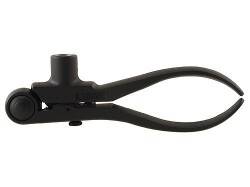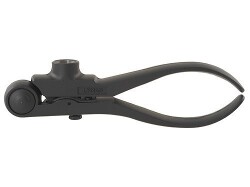Lyman 310 Tool
Comments, corrections, pontification? Contact me
Using the Lyman #310 Tool
Resources
Ideal Quick Reference
(Cartridge, Adapter Die, Priming Die, M/R die, Expander Plugs, Seater
Screws)
History
of the Ideal 310 (originally from "The 310 Outpost" may it
RIP)
Lyman Modern Bullet Shapes
Ideal
/ Lyman Mold Reference
Questions:
(Hat trick to Lyman
310
Tool
Q&A)
What is the difference between the Small and Large handles?
The Large handles have a longer boss (3/4
inch long) for rifle dies to thread into. Pistol dies may end up being
too short in the Long die.The handle length is the same.
The large boss measures 1.425" from the inside of the handle to the
outer end; the short boss mikes 1.050". You could trim the boss of
a large handle back about 3/8" until the pistol dies work OK


What are the Dimensions of the Short, Medium, and Long Expanding
Chambers / Muzzle Resizers?
ktw says:
Short:
1.560"
(+/-)
Medium: 2.130" (+/-)
Long: 2.500" (+/-)
These are nominal dimensions of the die bodies
based on measuring
several of each from my sets. There was typically some slight variation
from this in the actual measurements. Most of those variations were a
couple thousandths (.001) one way or the other. One short body was
.010" shorter than nominal. Another (an old long marked "13") was .014"
shorter than nominal. [ed. usual sized dies are 5/8x30]
Old vs New Dies: (Adapter Die)
Old style is basically case specific. New
style uses a threaded Adapter Die that fits the case head. The Adapter Die fits into a threaded hole that is
counter-bored slightly on
the inside, and has a screw adjustable hook projecting into it from the
opposite handle. The reason for the counter-bore is to provide a stop
shoulder for the case insert, which should be threaded into the handle
(from the inside) as far as possible, and stopping with the groove in
the case insert aligned with the hook. In use, this hook will drop into
the recess and snag on the case rim, and pull it out when the handles
are opened. Use the adjustment screw to assure it is set properly for
your type of ammo. The Adapter Die has the same number as the Priming
Chamber.
5 Die vs 4 Die Set vs 3 Die Set
A five die set has (1) decapper, (2)
priming chamber, (3) muzzle resizer [MR], (4) muzzle expander [M die
type], and (5) DA [double adjustable] chamber.
A four die set has (1) Neck Resize / Decap (MR / Decapper
combo), (2) Neck Expanding [M die type], (3) Priming Chamber,
and (4) DA [Double Adjustable] chamber.
A 3 die set (Truline/310) has no priming chamber,
thus will be 3 die sets, ie MR/decapper + expander die + DA (seater).
The Tru-Line Jr. press started out by using the 310 dies,
but the later version with the two-piece linkage (a straight, blued
metal link driving a second, L-shaped link on each side) used dies
having full-length sizing capability for pistol cases and shorter rifle
cases like the .222 family, the .22 Hornet, etc. They take a special
shell-holder, but you can get an adapter from Lyman that takes
RCBS-type ones. The priming system is pretty poor on these, but priming
separately in the 310 tool gives you a chance to inspect and clean
pockets as I prefer to do.
The Ezy-Loader thas three 7/8x14 holes. Although normal
7/8x14 dies fit outboard holes, the central hole is constrained by
linkage. For the center hole, use either a 5/8x30 die in a thread
adapter, a thin 7/8x14 die, or an "upside down" 5/8x30 die (case enters
other end!).
Interchangeability
of
Old
Style
to New Style:
Find the caliber of the cartridge, then the
number of the Adapter Die. Any other cartridge having the same Adapter
Die number is interchangeable in those handles.
The New Style #310 Tool is listed
in
the
following
table. This new style
can be identified by the adjustable extractor hook, and the adapter die.
To find the interchangeability of the Old Style #310 Tool handles
(those without adjustable extractor hook and adapter die) refer to the
caliber of the cartridge in Column 1. Then find the number of the
adapter in Column 3. Any other cartridge having the same adapter number
is interchangeable in those handles.
What Reloading Tools use 5/8 Dies?
When searching for 310 sized dies, look
for dies that fit the Ideal/Lyman 310 Tool, the Tru-Line
Junior Press (older version), and the Ezy-Loader (requires 5/8x30 to
7/8x14 thread
adapter). Note: The Ezy-Loader could and did use uniquely reversed
5/8x30 dies in the center hole...
What is the thread?
Small and Large Handles use .609" x 30
(5/8x30). Large special dies used 11/16x30, small special dies
used a .400x30 die.
Decapping pins? Lyman Part number 7837786 (10 pack).
Can I use these in a standard 7/8 X 14 press?
Yes, use a Lyman 7/8"-14 Thread Adapter
for 310 Dies and Model 55 Powder Measure, part number 7392036.

Will the 310 Tool Full Length Size?
No. Neck size only. There was a seperate
full length tool, where you forced the case into the die, then used a
steel rod to pound the case back out.
What Seating Screw goes with my Cast Boolit?
The 310 Tool cast bullet seating screw
uses the same number as the Lyman Top Punch used to size your boolit. Lyman Top
Punches list or the combined Castpics and Dark Canyon list.
What are the changes?
Paul
B says: I have and use the Lyman 310 tools quite a bit. However, I
do not like the current version as well as earlier models. The
older version neck sized only and you decapped with a separate die.
There was five dies to the set. Current versions only have four dies,
the decapper also neck sizes at the same time. For some reason, this
seems to make neck sizing and decapping a bit more stiff doing the
process.
Wheezengeezer
says: The dies are the 5/8-30 thread which is used on all but the
special handles. A 4 die set will have a deprime/neck size, prime,
expand, and a seat/crimp. The 310 came out after WW2, were steel
handles and had the caliber stamped on them.An adjustable rim hook was
added in 57 along with a threaded adaptor to allow different case
sizes. In 58 the handles were changed to an aluminum alloy. The pistol
and small rifle used the small handles and longer cases used large. The
threads were the same but the threaded boss was longer for the large.
The special used a larger thread and was used on few large rifle
calibers such as 348 Win. I have several sets and load several rifle
and handgun calibers.I can send some scans of the user manual and also
die code information.The older dies were only marked with a number. Any
die set marked with FL is not intended for use with the 310 or the
early TruLine JR. I prefer the feel of priming with the 310 or my
prewar #10 above anything else.You can make quality ammo with the 310
and keep it and cases, powder, primers and bullets in a shoebox
Now this explains some oddities- why there are more dies listed
on ebuy versus what are listed in the various manuals that I've seen.
What is an Ammunition Maker?
BCall says:
It is a set of 310 dies and large handles, a lead dipper,
a single
cavity mold with handles, and a 310 bullet sizing die. Came with a
small pack of gas checks and a powder dipper, with instructions on how
to cast and make ammo.
------------------------------------------------------------
Antique Reloading Tool Collector's Association: Ideal Tools: Ideal Tong
Tool Die Dimensions
------------------------------------------------------------
Posted by Doug Elliott on Saturday, April 21, 2007 - 10:00 am:
I have been casually referring to the threading on the "standard" 310
and earlier Ideal tong tool dies as being 5/8" x 30 threads per inch;
and the oversize ones for the largest cases (.348, .50-70) as 11/16" x
30 tpi. Recently, a correspondent (Mark Steele) had an inquiry about
some "small" dies in .25-20 SS, used in a No. 3 tool inherited from his
father, and these turned out to be threaded 0.400" x 30 tpi.
Apparently, Ideal's founder, John Barlow, had adopted the 30 threads
per inch standard from his days working for Winchester, where that
thread pitch was employed for similar applications - I have also
encountered a 1/4" x 30 tpi on an early Ideal sight adjusting tool.
This was all before the standardization of thread diameters, pitches
and tolerances in the early 1900s by the Society of Automotive
Engineers,
and the 30-tpi pitch is now an "orphan", with taps and dies very much a
specialty item.
I said that I have been referring to the "standard" tong tool die
thread as 5/8" (0.625") diameter. I have just gone out and miked
several dies, and find that the diameter is actually 0.605", plus or
minus a couple of thousandths - twenty thousandths under the nominal
5/8", and well beyond the normal range of tolerance. Similarly, a .348
die set for the 310 tool mikes 0.656" over the threads, well under the
nominal 0.6875" for 11/16". So, one might casually refer to the 0.400"
x 30 tpi "small" dies as being threaded an oversize 3/8" (0.375"), or
even a
grossly undersized 7/16" (0.4375"). (Incidentally, this is the same
thread used on the large decapping stems for the 310 tools.) I guess
the real answer is that Winchester, Barlow, et al., were not working to
specific inch dimensions in the first place, but chose diameters
and threadings that were appropriate and necessary for the job at hand.
This really all came out as Mark, Ken Neeld, Al Krause and I were
comparing and sorting the similar dies made by Earl Naramore and C. C.
Johnson for their little "Red Head" three-station turret press from the
late 1930s and '40's, which adopted the Lyman /Ideal standard die
threads. (The Lyman Tru-Line Junior, a similar concept, did not appear
on the market until 1947.) In this context, it is amusing - and a
little alarming - that Naramore, in his ca. 1940 introductory brochure
for the Red Head, states:
"Ideal tools and chambers [dies] for cartridges larger that 1/2 inch
are of a special large size and these chambers will not fit the
RED-HEAD press. However, these chambers can, in many instances, be
turned down and rethreaded to fit the press ...for $1.00 per set of
three."
Since the root diameter of an 0.605" x 30 tpi thread is approximately
0.550", this would not have been a practical proposition for dies for
the .348 (case head diameter 0.553") or .50-70 (0.565"), though it
might have worked for the oversize dies furnished in earlier years for
cartridges in the .45-70 (0.500") class.
Finally - though it is out of the ARTCA's 50-years+ range for "antique"
loading tools - I should mention the Australian "Super
Simplex" bench three-station (currently expanded to six) turret press,
which partakes of features of both the Red Head and Tru-Line Jr.
presses, with some features of its own. It, too uses dies of nominal
5/8" diameter (actual measurement 0.616"), but threaded to the British
Standard 5/8" x 26 tpi employed for brass fittings.
I will probably continue to refer to the Ideal standard and oversize
dies as 5/8" x 30 tpi and 11/16" x 30 tpi for convenience; but in the
awareness that these are not exact specifications.
Doug Elliott


